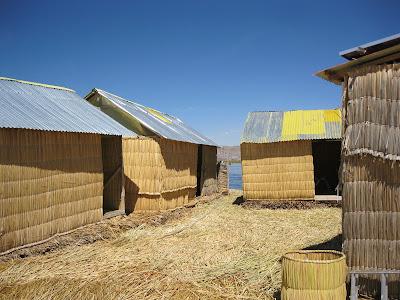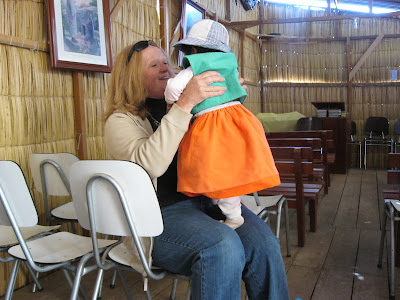The morning after our Sacred Valley tour we boarded a bus and headed out on our 7 hour trip to Puno. The road from Cusco to Puno took us through the Altiplano region of Peru. These high plains are dry, covered with ancient terraces, and get extremely cold in the winter time. Although there were some beautiful places along the way, most of the trip featured very barren looking areas where people live in the most basic of dwellings and eek out an existence of ranching, adobe brick making, or something like that.
As we drove along the road, we started to notice that breathing became more and more difficult. Steve had planned our trip carefully so that we slowly rose in altitude as we traveled to our destination. Puno was our highest elevation and was the first place we really noticed the breathing difficulties. I would start to fall asleep in my bus seat and would find myself waking up trying to catch my breath. Not gonna lie....it was a little scary.
About an hour out of Puno we went through the town of Juliaca. This is the location of the airport that we would fly back to Lima from in a few days. Since I had not been smart enough to take any photos from the bus through the Altiplano, I decided to take a few in Juliaca and along the road to Puno. Here are a few of those photos.
A little corner market
One of the interesting forms of transportation found in the cites
The barren lands between Juliaca and Puno
Our first look at Lake Titicaca, the highest navigable lake in the world
The city of Puno
It is built along the banks of Lake Titicaca and spreads up into the surrounding hills. We settled into our family owned hostel, rested a little, and then headed down to the port where the markets were. After buying a few items, we headed back up into town and did a little sight seeing and got a yummy dinner in a restaurant that had a nice brick oven fire going. Occasionally, we still noticed that breathing was a little difficult, but we still had a nice afternoon and evening in the city.
Steve and Megan in front of the Cathedral de Puno
Steve and Megan in front of the same Cathedral the next day
School children across from our hostel were practicing a native dance out on the playground. It was really fun to watch them out our window.
Our second day in Puno was one of our favorites of the whole Peruvian adventure. Our friend, Nelson, (who we had never actually met before) came and picked us up to take us to his home on the floating islands of Lake Titicaca. Our son Geoffrey had met him in the Spring when he traveled to Peru on an engineering outreach trip with fellow BYU students. They had participated in several projects to improve the lives of the people in the areas they traveled to. On the floating islands they had assembled a water filtration system to clean the water that the people previously drank straight from the lake.
Megan, Nelson, and I
Heading out in Nelson's boat
Puno in the background
Looking out on the reeds in the lake
These groups of reeds serve as the basis of life on the islands
A beautiful day on Lake Titicaca
One of the islands we passed on the way with their welcome sign
The islands are built from piling layer upon layer of the reeds on each other and anchoring the floating raft-like island to a pole stuck deep in the floor of this shallow part of the lake.
They also use the reeds to construct boats. Nelson and his father build these boats as part of their livelihood. He said that it takes about one month to construct one boat.
Women in traditional clothing waiting to meet tourists who come to the islands to see the very different way of life that exists here
Almost there
Nelsons island with their welcome sign
A side view of the island shows the stacked reeds. The islands disintegrate from the bottom so it is necessary for a new layer of reeds to be applied to the top every 20 days or so. This island was extremely well maintained since it not only had Nelson's home and his father's home, but also had the church buildings on it. We traveled to one other island as we left that day where the "ground" was much more squishy.
Nelson showed us these eggs he had gathered over several days amongst the reeds. With the exception of tourism, which is rapidly growing, these people are basically hunters and gatherers as far as food goes. They are also craftsman who sell their wares to augment their living.
The buildings of the church are also made of reeds but have metal roofs. There was a building for Relief Society, Primary, youth, and a Chapel.
Megan standing in the doorway of the Relief Society room
The youth room
Inside the chapel with little Marie Isabella and Nelson's wife, Dora
As we entered the humble church buildings and heard about their little branch of some 78 members, we could not hold back the tears. The spirit was amazing in this chapel of reeds and we knew we were in the presence of some of God's most faithful disciples.
Playing with Maria Isabella
Megan and I in the chapel
Can you guess what room this is....."Our primary colors are one, two, three......."
Dora, Maria Isabella, an Nelson Coila
They also have a son, Emerson, but he was at school during our visit
They had taken the root balls from the bottom of the lake and made little gardens on top of their island. They grew flowers and were also experimenting with potatoes.
These are the bundles of reeds they use to make their boats an rebuild their islands
The water filtration system built by the BYU students during their trip in the Spring
Nelson demonstrates how the water is pumped from below the island into the red filtration bucket and then into the green collection bucket. He said that a recent storm had knocked over the system, but because the students had shown him how to dissemble the unit for cleaning, he was able to put it back together again and it is working fine.
Megan, Dora, Maria Isabella, Nelson, and Steve outside the chapel
A woman gathering reeds that we saw as we left the islands. The softer white parts of the roots of the reeds are used as food.
It was an amazing journey to a place where the people are so humble and thankful for everything the Lord has blessed them with. We will remember it with great fondness for our whole lives.
The next morning we boarded a plane for Lima. This band was there in the airport to send us on our way. Ahhh, Peruvian music.





































No comments:
Post a Comment